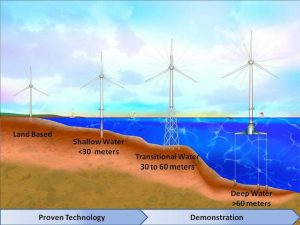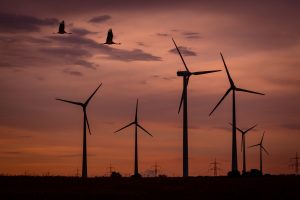
Six turbines planned near Cleveland
The Ohio Power Siting Board has given the preliminary go-ahead to six wind turbines planned for Lake Erie, about eight miles northwest of Cleveland. The project would be the first freshwater wind farm on the Great Lakes and the first in the nation. But even if plans become reality, the $126 million project is unlikely to ever turn a profit.
“The vision is a thriving industry that provides clean power,” said Dave Karpinski, vice-president of operations for Lake Erie Energy Development Company (LEEDCo.) The Icebreaker project is intended to test the waters, so to speak, in Great Lakes wind power. The high start-up costs mean the site cannot produce enough electricity to pay for itself. But the point, according to Karpinski, is to get turbines up and running. “To get there, you’ve got to demonstrate that it can be done and permitting is a big thing, that’s part of the demonstration.”
The turbines will be built by Vestas, a Danish company considered a worldwide leader in wind turbine technology and development. “Europe has been at this for about 25 years now,” Karpinski said, citing 16,000 MW of wind power on the continent. “They’ve reached scale and are growing.”
The OPSB is comprised of seven voting members, including representatives from the Ohio departments of Natural Resources, Agriculture and Health, Ohio Development Agency, Public Utilities Commission, Ohio Environmental Protection Agency and one public member. The OPSB’s role is to review proposals for energy-producing sites in the state, including wind, solar, natural gas and some electric lines and pipelines.
Quick Fact: Six turbines producing 20.7 megawatts peak (enough to power about 15,000 homes)
“On July 3 our staff issued a recommendation that the voting board allow the project to go forward subject to 34 conditions,” said Matt Butler, spokesman for the OPSB. A public meeting will be held at Cleveland City Hall July 19. Butler said most of the public opposition to Icebreaker has been from people and organizations with wildlife concerns, worried mostly about birds and bats.
“There’s been ongoing back-and-forth between Icebreaker and the ODNR,” Butler said. “There are things the applicant is expected to complete, with assistance from the ODNR and U.S. Fish & Wildlife Service.” Butler said the timeline currently in place could put turbines in the water and operating in less than three years. “I certainly thing this is an interesting project,” he said. “It’s the first that’s come before us and it presents a different set of challenges than land-based projects which usually have to do with landowner rights and property values and aesthetics.”
The list of 34 conditions includes shutting turbines down at night from March through December – unless LEEDCo can prove the site does not harm migrating wildlife crossing the lake. And Kim Kaufmann, executive director of Black Swamp Bird Observatory, said that proving the turbines won’t harm wildlife is all but impossible.
Quick Fact: Total height from surface of water to tip of topmost blade: about 495 feet
“Post-construction monitoring of birds and bat collisions can’t happen,” Kaufman explained. “The technology doesn’t exist. There’s no way to know whether a collision is a Kirtland’s warbler or a European starling.” Kaufman said Black Swamp will be at the upcoming hearing and will be submitting written comments.
The National Audubon Society has declared 10 Ohio counties, on or near Lake Erie, Globally Important Bird Areas, including Cuyahoga County, where the turbines would be located. In contrast, only four other sites in Ohio are listed, and they are very specific. Instead of thousands of square miles, the other sites can be accounted by acreage or a few dozen square miles.
According to Kaufman an essential goal now is to ensure that accurate information helps guide the future. “Until they’re in the water it’s not too late to be certain there’s good, scientific post-construction monitoring,” she said.
Quick Fact: Lowest point of spinning blades: about 73 feet from water
One of the 34 conditions includes installation of a sophisticated radar system near the site which will operate for two years before the system is erected. The radar should be able to detect airborne creatures weighing as little as a third of an ounce, including tracking the altitude and direction. In addition, post construction the radar must provide information that can be used to determine and quantify behavioral avoidance or attraction to turbines in the open water setting. The turbine blades must also must also include technology which detects collisions, to learn whether birds and bats are flying into the blades.

Progression of expected wind turbine evolution to deeper water, Image by the National Renewable Energy Laboratory via wikimedia cc 4.0
The ODNR declined to comment on all questions regarding the project, citing pending litigation.
John Hageman, retired from Ohio State University’s Stone Lab, says he has serious reservations about the entire project. In fact, he classified the entire project as a boondoggle-in-the-making, likely to benefit select engineers and consultants, with mostly temporary contractors.
“While the experiment with the six wind turbines off Cleveland won’t be the end of the world, the promoters have already revealed their plans to erect 1,000 or more of the monstrosities. That will totally destroy the lake as we currently know it for everyone else. I say chop the head off this Trojan horse.”
Quick Fact: Total length of each blade: about 202 feet
Hageman also expressed concern over the leasing of public property for profit-taking, especially when aesthetics is one of Lake Erie’s greatest resources. And while he acknowledged the plight of wildlife, he also cited human needs. “I like birds, don’t get me wrong, but aesthetics should not play a minor role in this,” he said.
Jocelyn Travis is the Sierra Club’s coordinator for the Ready for 100 program, which aims to have 100 major American cities using 100 percent clean energy by 2050, and she said she likes the project. In fact, Sierra Club is one of the intervenors, in court, supporting the project. “We want to help oversee the project and make certain that everything goes smoothly,” Travis said, going on to say the Sierra Club has been participating in public meetings. “I am very excited to see Cleveland move toward 100 percent clean energy.”
Travis said the Icebreaker project is an absolutely viable, real solution to creating a cleaner, healthier Ohio. “What we want is what’s best for all those in our community,” she said.
An adjudicatory meeting will be held in Columbus Aug. 6, for all parties of record with legal representation. The OPSB meets the third Thursday of each month and is likely to offer a final decision at the October or November meeting.
Featured Image: Middelgrunden offshore wind farm, Photo by Kim Hansen via wikimedia cc 3.0
(Editor’s Note: James Proffitt was a freelance reporter for papers in Cincinnati and northern Kentucky before moving to Marblehead, Ohio, and worked for Gannett’s Newspaper Network of Central Ohio as a reporter and photographer for eight years. He is now is a frequent contributor to the Outdoor News Network and Ohio.org tourism blog. Many of his news and photo features received AP awards and his verse and fiction have appeared in dozens of university and literary journals. He writes about fishing, hunting, outdoors, conservation and all things Lake Erie — and tributaries. In 2015, he published the book “Marblehead Lighthouse on Lake Erie: Ohio’s Historic Beacon” which is now in its second printing with Arcadia Press.)






